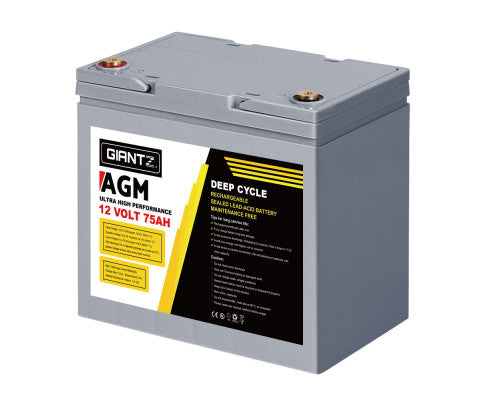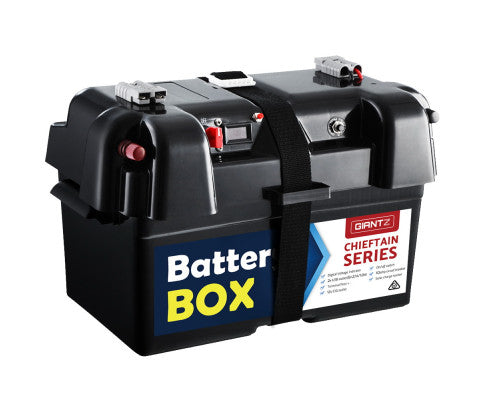What Are Deep Cycle Batteries?
Deep cycle batteries are a type of lead-acid battery designed to provide a consistent and steady amount of power over an extended period, making them ideal for applications that require prolonged or continuous energy supply. Unlike starter batteries used in vehicles, which provide a burst of energy to start engines, deep cycle batteries are designed for discharging a large portion of their capacity without being damaged.

How Do Deep Cycle Batteries Work?
Deep cycle batteries operate based on the principles of electrochemical reactions. Inside a deep cycle battery, there are lead plates immersed in an electrolyte solution, typically a mixture of water and sulfuric acid.
-
Electrochemical Reactions during Discharge:
- When the battery is in use (discharging), a chemical reaction occurs between the lead plates and the electrolyte, resulting in the conversion of chemical energy into electrical energy.
- Lead sulphate forms on the plates during discharge, and electrons flow through the external circuit to power devices.
-
Electrochemical Reactions during Charging:
- During the charging process, the chemical reaction is reversed. Electrical energy is supplied to the battery, causing the lead sulfate to break down back into lead plates and sulfuric acid.
Components of a Deep Cycle Battery:
-
Lead Plates:
- Deep cycle batteries have thicker lead plates compared to starter batteries. These plates are designed to endure repeated charge and discharge cycles without sustaining significant damage.
-
Electrolyte:
- The electrolyte (sulfuric acid solution) facilitates the chemical reaction between the lead plates, enabling the flow of electrons and the conversion of chemical energy into electrical energy.
-
Separator:
- A separator made of materials like polyethylene or rubber keeps the positive and negative plates from touching, preventing a short circuit while allowing the flow of ions between them.
Applications of Deep Cycle Batteries:
-
Renewable Energy Storage:
- Deep cycle batteries are crucial for storing excess energy generated from renewable sources like solar panels or wind turbines. This stored energy can be used during low or no energy production periods.
-
Marine and RV Power:
- Deep cycle batteries are commonly used to power appliances, lighting, and other electrical systems in boats, yachts, and recreational vehicles (RVs) when not connected to external power sources.
-
Golf Carts and Electric Vehicles:
- Deep cycle batteries provide the necessary power for electric vehicles like golf carts, forklifts, and other industrial electric vehicles that require sustained and reliable energy.
-
Off-Grid Power Systems:
- Deep cycle batteries are vital for off-grid homes, cabins, and remote installations to store energy for use when the primary power source, such as a generator or solar panels, is unavailable.
-
Backup Power for Homes and Businesses:
- Deep cycle batteries serve as backup power systems for homes and businesses, providing energy during power outages, ensuring critical systems remain operational.
Deep Cycle Battery Box
A deep cycle battery box is a protective container designed to house and safeguard deep cycle batteries used in various applications. The primary purpose of the battery box is to provide a secure and organized environment for the deep cycle battery, protecting it from external elements, damage, and ensuring safety during use and transportation.

The battery box is highly useful in a variety of applications, including marine vessels, RVs, off-grid power systems, backup power solutions, and more. It provides an organized and secure solution for housing deep cycle batteries, ensuring their safety and functionality while offering ease of handling and transport.
Battery Capacity
Deep cycle batteries come in various current capacities, often measured in ampere-hours (Ah), which represents the amount of current a battery can deliver over a specific period. The current capacity of a deep cycle battery is a crucial factor in determining how long the battery can power a device or system before requiring a recharge. Let's explain the different current capacities typically found in deep cycle batteries:
-
Low Capacity Deep Cycle Batteries (Below 50Ah):
- These batteries have a lower current capacity, suitable for smaller applications or devices that require less power over a short period. Examples include small portable electronic devices, some camping equipment, and low-power backup systems.
-
Medium Capacity Deep Cycle Batteries (50Ah to 150Ah):
- Batteries in this range offer a moderate amount of current capacity, making them versatile for a wide range of applications. A 100Ah battery can power moderately sized devices and systems for a reasonable duration. Applications include small to medium-sized RVs, boats, backup power for essential home appliances, and moderate off-grid power setups.
-
High Capacity Deep Cycle Batteries (150Ah and Above):
- These batteries provide a significant amount of current capacity, making them suitable for larger applications and extended use. They are commonly used in larger off-grid power systems, commercial backup power solutions, electric vehicles, larger marine vessels, and in situations where a substantial amount of power is needed for an extended period.
-
Very High Capacity Deep Cycle Batteries (300Ah and Above):
- Batteries in this category offer an extremely high current capacity and are ideal for heavy-duty applications that demand a substantial and sustained power supply. They are often used in large-scale off-grid setups, industrial equipment, electric forklifts, and other heavy machinery.
It's important to note that the specific current capacity needed for an application depends on various factors, including the power requirements of the devices or systems being powered, the expected duration of use before recharging, and the overall energy demands of the setup.
When selecting a deep cycle battery, it's crucial to carefully assess your power needs and choose a battery with an appropriate current capacity that can meet those needs while providing a safety margin for unexpected variations in power consumption. Additionally, considering factors such as the discharge rate and the depth of discharge is essential to ensure the battery's longevity and optimal performance.
Conclusion
Deep cycle batteries play a significant role in various applications, providing a reliable and consistent source of energy. Understanding their structure, functioning, and applications is crucial for efficient utilization and maintenance, ensuring optimal performance and longevity.


